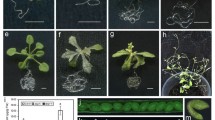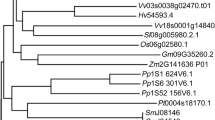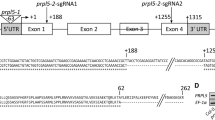Abstract
To gain insight into the functions of the nuclear-encoded factors involved in chloroplast development, we characterized the high chlorophyll fluorescence and pale green mutant 108-1 (designated as hfp108-1) of Arabidopsis thaliana. Map-based cloning revealed that the mutant contains a tandem repeat of part of the sequence (including 116 nucleotides from 631 to 746 bp downstream of the ATG) of At3g63190, which encodes a chloroplast ribosome recycling factor homologue and was named AtcpRRF. The chloroplasts of hfp108-1 plants contain few internal thylakoid membranes and are severely defective in the accumulation of chloroplast-encoded proteins. In vivo labeling experiments showed a drastic decrease in the synthesis of the chloroplast-encoded proteins, which may be attributed primarily to reduced translation of the corresponding mRNA molecules. The level of the HFP108 transcript was greatly reduced in hfp108-1, so hfp108-1 showed a weak phenotype, and null alleles of HFP108 (hfp108-2) were embryonic lethal. Observations with cleared seeds in the same silique showed that homozygous hfp108-2 seeds were blocked at the heart stage and did not develop further. Thus, these results suggest that AtcpRRF is essential for embryogenesis and chloroplast biogenesis.







Similar content being viewed by others
Explore related subjects
Discover the latest articles and news from researchers in related subjects, suggested using machine learning.References
Abdallah F, Salamini F, Leister D (2000) A prediction of the size and evolutionary origin of the proteome of chloroplasts of Arabidopsis. Trends Plant Sci 5:141–142
Ahlert D, Ruf S, Bock R (2003) Plastid protein synthesis is required for plant development in tobacco. Proc Natl Acad Sci USA 100:15730–15735
Akkaya MS, Welsch PL, Wolfe MA, Duerr BK, Becktel WJ, Breinberger CA (1994) Purification and N-terminal sequence analysis of pea chloroplast protein synthesis factor EF-G. Arch Biochem Biophys 308:109–117
Albert S, Després B, Guilleminot J, Bechtold N, Pelletier G, Delseny M, Devic M (1999) The EMB 506 gene encodes a novel ankyrin repeat containing protein that is essential for the normal development of Arabidopsis embryos. Plant J 17:169–179
Albrecht V, Ingenfeld A, Apel K (2006) Characterization of the snowy cotyledon 1 mutant of Arabidopsis thaliana: the impact of chloroplast elongation factor G on chloroplast development and plant vitality. Plant Mol Biol 60:507–518
Apuya NR, Yadegari R, Fischer RL, Harada JJ, Zimmerman JL, Goldberg RB (2001) The Arabidopsis embryo mutant schlepperless has a defect in the chaperonin-60 alpha gene. Plant Physiol 126:717–730
Apuya NR, Yadegari R, Fischer RL, Harada JJ, Goldberg RB (2002) RASPBERRY3 gene encodes a novel protein important for embryo development. Plant Physiol 129:691–705
Barkan A (1993) Nuclear mutants of maize with defects in chloroplast polysome assembly have altered chloroplast RNA metabolism. Plant Cell 5:389–402
Barkan A (1998) Approaches to investigating nuclear genes that function in chloroplast biogenesis in land plants. Methods Enzymol 297:38–57
Bellaoui M, Keddie JS, Gruissem W (2003) DCL is a plant-specific protein required for plastid ribosomal RNA processing and embryo development. Plant Mol Biol 53:531–543
Bult CJ, White O, Olsen GJ, Zhou L, Fleischmann RD, Sutton GG, Blake JA, FitzGerald LM, Clayton RA, Gocayne JD, Kerlavage AR, Dougherty BA, Tomb JF, Adams MD, Reich CI, Overbeek R, Kirkness EF, Weinstock KG, Merrick JM, Glodek A, Scott JL, Geoghagen NS, Venter JC (1996) Complete genome sequence of the methanogenic archaeon, Methanococcus jannaschii. Science 273:1058–1073
Cai W, Ji D, Peng L, Guo J, Ma J, Zou M, Lu C, Zhang L (2009) LPA66 is required for editing psbF chloroplast transcripts in Arabidopsis. Plant Physiol 150:1260–1271
Campos F, Garcia-Gomez BI, Solorzano RM, Salazar E, Estevez J, Leon P, Alvarez-Buylla ER, Covarrubias AA (2001) A cDNA for nuclear-encoded chloroplast translational initiation factor 2 from a higher plant is able to complement an infB Escherichia coli null mutant. J Biol Chem 276:28388–28394
Chi W, Ma JF, Zhang DY, Guo JK, Chen F, Lu CM, Zhang LX (2008) The pentatricopeptide repeat protein DELAYED GREENING1 is involved in the regulation of early chloroplast development and chloroplast gene expression in Arabidopsis. Plant Physiol 147:573–584
Chiu W, Niwa Y, Zeng W, Hirano T, Kobayashi H, Sheen J (1996) Engineered GFP as a vital reporter in plants. Curr Biol 6:325–330
Clough SJ, Bent AF (1998) Floral dip: a simplified method for Agrobacterium-mediated transformation of Arabidopsis thaliana. Plant J 16:735–743
Hernandez-Torres J, Breitenberger CA, Spielmann A, Stutz E (1993) Cloning and sequencing of a soybean nuclear gene coding for a chloroplast translation elongation factor EF-G. Biochim Biophys Acta 1174:191–194
Hirashima A, Kaji A (1970) Factor dependent breakdown of polysomes. Biochem Biophys Res Commun 41:877–883
Hirokawa G, Inokuchi H, Kaji H, Igarashi K, Kaji A (2004) In vivo effect of inactivation of ribosome recycling factor-fate of ribosomes after unscheduled translation downstream of open reading frame. Mol Microbiol 54:1011–1021
Hirokawa G, Nijman RM, Raj VS, Kaji H, Igarashi K, Kaji A (2005) The role of ribosome recycling factor in dissociation of 70S ribosomes into subunits. RNA 11:1317–1328
Hirokawa G, Demeshkina N, Iwakura N, Kaji H, Kaji A (2006) The ribosome-recycling step: consensus or controversy? Trend Biochem Sci 31:143–149
Hirokawa G, Iwakura N, Kaji A, Kaji H (2008) The role of GTP in transient splitting of 70S ribosomes by RRF (ribosome recycling factor) and EF-G (elongation factor G). Nucleic Acids Res 36:6676–6687
Hirose T, Ideue T, Wakasugi T, Sugiura M (1999) The chloroplast infA gene with a functional UUG initiation codon. FEBS Lett 445:169–172
Ichikawa S, Kaji A (1989) Molecular cloning and expression of ribosome releasing factor. J Biol Chem 264:20054–20059
Janosi L, Shimizu I, Kaji A (1994) Ribosome recycling factor (ribosome releasing factor) is essential for bacterial growth. Proc Natl Acad Sci USA 91:4249–4253
Janosi L, Ricker R, Kaji A (1996) Dual function of ribosome recycling factor in protein biosynthesis: Disassembling the termination complex and preventing translational errors. Biochimie 78:959–969
Janosi L, Mottagui-Tabar S, Isaksson LA, Sekine Y, Ohtsubo E, Zhang S, Goon S, Nelken S, Shuda M, Kaji A (1998) Evidence for in vivo ribosome recycling, the fourth step in protein biosynthesis. EMBO J 17:1141–1151
Jensen KH, Herrin DL, Plumley FG, Schmidt GW (1986) Biogenesis of photosystem II complexes: transcriptional, translational and posttranslational regulation. J Cell Biol 103:1315–1325
Kaji A, Teyssier E, Hirokawa G (1998) Disassembly of the post-termination complex and reduction of translational error by ribosome recycling factor (RRF)-A possible new target for antibacterial agents. Biochem Biophys Res Commun 250:1–4
Kaji A, Kiel MC, Hirokawa G, Muto AR, Inokuchi Y, Kaji H (2001) The fourth step of protein synthesis: disassembly of the posttermination complex is catalyzed by elongation factor G and ribosome recycling factor, a near-perfect mimic of tRNA. Cold Spring Harb Symp Quant Biol 66:515–529
Lee KH, Kim DH, Lee SW, Kim ZH, Hwang I (2002) In vivo import experiments in protoplasts reveal the importance of the overall context but not specific amino acid residues of the transit peptide during import into chloroplasts. Mol Cells 14:388–397
Lukowitz W, Gillmor CS, Scheible WR (2000) Positional cloning in Arabidopsis: why it feels good to have a genome initiative working for you. Plant Physiol 123:795–806
Ma J, Peng L, Guo J, Lu Q, Lu C, Zhang L (2007) LPA2 is required for efficient assembly of photosystem II in Arabidopsis thaliana. Plant Cell 19:1980–1993
Mansfield SG, Briarty LG (1991) Early embryogenesis in Arabidopsis thaliana. II. The developing embryo. Can J Bot 69:461–476
Martínez-García JF, Monte E, Quail PH (1999) A simple, rapid and quantitative method for preparing Arabidopsis protein extracts for immunoblot analysis. Plant J 20:251–257
Meinke DW (1994) Seed development in Arabidopsis thaliana. In: Meyerowitz EM, Somerville CR (eds) Arabidopsis. Cold spring Harbor Laboratory Press, New York, pp 253–259
Meurer J, Berger A, Westhoff P (1996a) A nuclear mutant of Arabidopsis with impaired stability on distinct transcripts of the plastid, psbB, psbD/C, ndhH, and ndhC operons. Plant Cell 8:1193–1207
Meurer J, Meierhoff K, Westhoff P (1996b) Isolation of high-chlorophyll-fluorescence mutants of Arabidopsis thaliana and their characterization by spectroscopy, immunoblotting and northern hybridisation. Planta 198:385–396
Meurer J, Plücken H, Kowallik KV, Westhoff P (1998) A nuclear-encoded protein of prokaryotic origin is essential for the stability of photosystem II in Arabidopsis thaliana. EMBO J 17:5286–5297
Meurer J, Lezhneva L, Amann K, Gödel M, Bezhani S, Sherameti I, Oelmüller R (2002) A peptide chain release factor 2 affects the stability of UGA-containing transcripts in Arabidopsis chloroplasts. Plant Cell 14:3255–3269
Motohashi R, Nagata N, Ito T, Takahashi S, Hobo T, Yoshida S, Shinozaki K (2001) An essential role of a TatC homologue of DpH-dependent protein transporter in thylakoid membrane formation during chloroplast development in Arabidopsis thaliana. Proc Natl Acad Sci USA 98:10499–10504
Motohashi R, Ito T, Kobayashi M, Taji T, Nagata N, Asami T, Yoshida S, Yamaguchi-Shinozaki K, Shinozaki K (2003) Functional analysis of the 37-kDa inner envelope membrane polypeptide in chloroplast biogenesis, using a Ds-tagged Arabidopsis pale green mutant. Plant J 34:719–731
Motohashi R, Yamazaki T, Myouga F, Ito T, Ito K, Satou M, Kobayashi M, Nagata N, Yoshida S, Nagashima A, Tanaka K, Takahashi S, Shinozaki K (2007) Chloroplast ribosome release factor 1 (AtcpRF1) is essential for chloroplast development. Plant Mol Biol 64:481–497
Murashige T, Skoog F (1962) A revised medium for rapid growth and bioassays with tobacco tissue cultures. Physiol Plant 15:473–497
Myouga F, Motohashi R, Kuromori T, Nagata N, Shinozaki K (2006) An Arabidopsis chloroplast-targeted Hsp101 homologue, APG6, has an essential role in chloroplast development as well as heat-stress response. Plant J 48:249–260
Peng L, Ma J, Chi W, Guo J, Zhu S, Lu Q, Lu C, Zhang L (2006) LOW PSII ACCUMULATION1 is involved in efficient assembly of photosystem II in Arabidopsis thaliana. Plant Cell 18:955–969
Pih KT, Yi MJ, Liang YS, Shin BJ, Cho MJ, Hwang I, Son D (2000) Molecular cloning and targeting of a fibrillarin homolog from Arabidopsis. Plant Physiol 123:51–58
Rochaix JD (1996) Post-transcriptional regulation of chloroplast gene expression in Chlamydomonas reinhardtii. Plant Mol Biol 32:327–341
Rochaix JD, Kuchka M, Mayfield S, Schirmer-Rahire M, Girard-Bascou J, Bennoun P (1989) Nuclear and chloroplast mutations affect the synthesis or stability of the chloroplast psbC gene product in Chlamydomonas reinhardtii. EMBO J 8:1013–1021
Rolland N, Janosi L, Block MA, Teyssier E, Miége C, Chéniclet C, Carde J-P, Kaji A, Joyard J (1999) Plant ribosome recycling factor homologue is a chloroplastic protein and is bactericidal in Escherichia coli carrying temperature-sensitive ribosome recycling factor. Proc Natl Acad Sci USA 96:5464–5469
Rorbach J, Richter R, Wessels HJ, Wydro M, Pekalski M, Farhoud M, Kühl I, Gaisne M, Bonnefoy N, Smeitink JA, Lightowlers RN, Chrzanowska-Lightowlers ZM (2008) The human mitochondrial ribosome recycling factor is essential for cell viability. Nucleic Acids Res 36:5787–5799
Ruppel NJ, Hangarter RP (2007) Mutations in a plastid-localized elongation factor G alter early stages of plastid development in Arabidopsis thaliana. BMC Plant Biol 7:37
Ryoji M, Berland R, Kaji A (1981a) Reinitiation of translation from the triplet next to the amber termination codon in the absence of ribosome-releasing factor. Proc Natl Acad Sci USA 78:5973–5977
Ryoji M, Karpen JW, Kaji A (1981b) Further characterization of ribosome releasing factor and evidence that it prevents ribosomes from reading through a termination codon. J Biol Chem 256:5798–5801
Sambrook J, Russell DW (2001) Molecular clone, a laboratory manual. Cold Spring Harbor Laboratory Press, New York
Sato S, Nakamura Y, Kaneko T, Asamizu E, Tabata S (1999) Complete structure of the chloroplast genome of Arabidopsis thaliana. DNA Res 6:283–290
Schmidt G, Mishkind N (1983) Rapid degradation of unassembled ribulose 1, 5-bisphosphate carboxylase small subunits in chloroplasts. Proc Natl Acad Sci USA 80:2632–2636
Schult K, Meierhoff K, Paradies S, Töller T, Wolff P, Westhoff P (2007) The Nuclear-encoded factor HCF173 is involved in the initiation of translation of the psbA mRNA in Arabidopsis thaliana. Plant Cell 19:1329–1346
Sugita M, Sugiura M (1996) Regulation of gene expression in chloroplasts of higher plants. Plant Mol Biol 32:315–326
Sugiura M (1992) The chloroplast genome. Plant Mol Biol 19:149–168
Uwer U, Willmitzer L, Altmann T (1998) Inactivation of a glycyl-tRNA synthetase leads to an arrest in plant embryo development. Plant Cell 10:1277–1294
Weigel D, Ahn JH, Blázquez MA, Borevitz JO, Christensen SK, Fankhauser C, Ferrándiz C, Kardailsky I, Malancharuvil EJ, Neff MM, Nguyen JT, Sato S, Wang Z, Xia Y, Dixon RA, Harrison MJ, Lamb CJ, Yanofsky MF, Chory J (2000) Activation tagging in Arabidopsis. Plant Physiol 122:1003–1014
Yu J, Vermaas W (1990) Transcript levels and synthesis of photosystem II components in cyanobacterial mutants with inactivated photosystem II genes. Plant Cell 2:315–322
Yu J, Vermaas W (1993) Synthesis and turnover of photosystem II reaction centre polypeptides in cyanobacterial D2 mutants. J Biol Chem 268:7407–7413
Zerges W (2000) Translation in chloroplasts. Biochimie 82:583–601
Acknowledgments
We gratefully acknowledge the Arabidopsis Biological Resource Center for the Arabidopsis seeds. This research was supported by the National Natural Science Foundation of China (30725003) and National Basic Research Program of China (2009CB118500).
Author information
Authors and Affiliations
Corresponding author
Rights and permissions
About this article
Cite this article
Wang, L., Ouyang, M., Li, Q. et al. The Arabidopsis chloroplast ribosome recycling factor is essential for embryogenesis and chloroplast biogenesis. Plant Mol Biol 74, 47–59 (2010). https://doi.org/10.1007/s11103-010-9653-0
Received:
Accepted:
Published:
Issue Date:
DOI: https://doi.org/10.1007/s11103-010-9653-0




